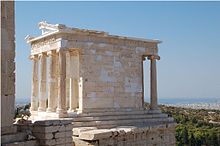amphiprostyle
Jump to navigation
Jump to search
English[edit]


Etymology[edit]
From Latin amphiprostylos, from Ancient Greek ἀμφιπρόστυλος (amphipróstulos), from ἀμφί (amphí) + πρόστυλος (próstulos, “having pillars”).
Adjective[edit]
amphiprostyle (not comparable)
- (architecture, chiefly historical, of a temple or edifice) Having columns at either end but not along the sides.
- 1806, Thomas Gabb, Finis Pyramidis, page 19:
- This much being sufficiently proved; before I draw the inference in contemplation, I have next to prove, the original temple was amphiprostyle, and hexastyle.
- 1854, Robert Stuart, “Amphiprostylos”, in Cyclopedia of Architecture, volume 1, page 136:
- Another characteristic of amphiprostyle temples was that of their porticoes, consisting of four columns only.
- 1993, Ira S. Mark, The Sanctuary of Athena Nike in Athens:
- "The Ilissos Temple is the first attested amphiprostyle temple in Greek architecture."
Synonyms[edit]
Related terms[edit]
Translations[edit]
having columns at either end but not along the sides
|
Noun[edit]
amphiprostyle (plural amphiprostyles)
- (architecture, historical) An amphiprostyle temple or edifice.
- 1819, Periptere, Abraham Rees, The Cyclopædia: Or, Universal Dictionary of Arts, Sciences, and Literature, Volume 26, unnumbered page,
- Peripteres were properly temples which had columns on all the four ſides; by which they were distinguished from proſtyles, and amphiproſtyles, the one of which had no columns before, and the other none on the sides.
- 1819, Periptere, Abraham Rees, The Cyclopædia: Or, Universal Dictionary of Arts, Sciences, and Literature, Volume 26, unnumbered page,
Translations[edit]
amphiprostyle temple
|
Further reading[edit]
 amphiprostyle on Wikipedia.Wikipedia
amphiprostyle on Wikipedia.Wikipedia  List of Ancient Greek temples on Wikipedia.Wikipedia
List of Ancient Greek temples on Wikipedia.Wikipedia
Latin[edit]
Noun[edit]
amphiprostȳle
Categories:
- English terms derived from Latin
- English terms derived from Ancient Greek
- English lemmas
- English adjectives
- English uncomparable adjectives
- en:Architecture
- English terms with historical senses
- English terms with quotations
- English nouns
- English countable nouns
- Latin non-lemma forms
- Latin noun forms
- Latin terms spelled with Y